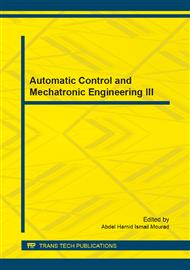p.194
p.201
p.208
p.215
p.222
p.229
p.236
p.240
p.244
Anti-Collision Technique of SAW Tags Using Walsh Code
Abstract:
—In view of the inefficiency of coding, the complexity of signal extraction and the strict demands of machining in the existing multiple SAW tags system, an anti-collision technique based on Walsh Code was proposed. First, it encodes the 2PSK using the single antenna transmission structure, then it implements the orthogonal encoding of each tag in a multiple SAW tags system using Walsh coding, and finally the encoding information of each tag is acquired by reading the echo signals from the reader and doing cross-correlation operation with each code block in the orthogonal code-set. The proposed approach incorporates both the coding efficiency and the processing technology, simplifies the complexity of signal extraction, and achieves the goal of anti-collision of multiple SAW tags system. The theoretical analysis and simulation verify the feasibility of this technique.
Info:
Periodical:
Pages:
222-228
Citation:
Online since:
August 2014
Authors:
Keywords:
Price:
Сopyright:
© 2014 Trans Tech Publications Ltd. All Rights Reserved
Share:
Citation:


